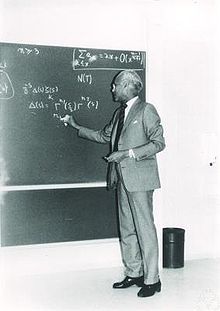Komaravolu Chandrasekharan (21 November 1920 – 13 April 2017)[1] was a professor at ETH Zurich[2] and a founding faculty member of School of Mathematics, Tata Institute of Fundamental Research (TIFR). He is known for his work in number theory and summability. He received the Padma Shri, the Shanti Swarup Bhatnagar Award, and the Ramanujan Medal, and he was an honorary fellow of TIFR. He was president of the International Mathematical Union (IMU) from 1971 to 1974.
Komaravolu Chandrasekharan | |
|---|---|
 | |
| Born | 21 November 1920 |
| Died | 13 April 2017 (aged 96) |
| Citizenship | Indian |
| Alma mater | Madras University |
| Occupation | Mathematician |
| Known for | Administrative intellect, Mathematics, Analytic Number Theory and Mathematical Analysis |
| Awards | Srinivasa Ramanujan Medal (1966), Padma Shri (1959), Shanti Swarup Bhatnagar Award for Mathematical Sciences (1963) |
| Scientific career | |
| Fields | Number theory |
| Institutions | TIFR, ETH Zurich |
| Doctoral advisor | K. Ananda Rau |
| Doctoral students | C. S. Seshadri M. S. Narasimhan |
Biography
editChandrasekharan was born on 21 November 1920 in Machilipatnam, Andhra Pradesh. Chandrasekharan completed his high school from Bapatla village in Guntur from Andhra Pradesh. He completed M.A. in mathematics from the Presidency College, Chennai and a PhD from the Department of Mathematics, University of Madras in 1942, under the supervision of K. Ananda Rau.[1]
When Chandrasekharan was with the Institute for Advanced Study, Princeton, US, Homi Bhabha invited Chandrashekharan to join the School of Mathematics of the Tata Institute of Fundamental Research (TIFR). Chandrashekharan persuaded mathematicians L. Schwarz, C. L. Siegel and others from all over the world to visit TIFR and deliver lectures. In 1965, Chandrasekharan left the Tata Institute of Fundamental Research to join the ETH Zurich,[1] where he retired in 1988.[3][4]
He was a fellow of the American Mathematical Society.[5]
Selected works
edit- with Salomon Bochner: Fourier Transforms. Princeton University Press. 1949.[6]
- with S. Minakshisundaram: Typical means. Oxford University Press. 1952. LCCN 53002509.[7]
- Introduction to analytic number theory. Springer. 1968. LCCN 68021990.[8][9] reprinting 2012
- Arithmetical Functions. Grundlehren der Mathematischen Wissenschaften. Springer. 1970. LCCN 49010722.[8]
- Elliptic Functions. Springer. 1985. ISBN 9780387152950. LCCN 85009802.
- Classical Fourier transforms. Springer-Verlag. 1989. ISBN 0387502483. LCCN 88038192.[10]
- Course on topological groups. Hindustan Book Agency. 2011. ISBN 9789380250205.[11]
- Course on integration theory. Hindustan Book Agency. 2011. ISBN 9789380250199. LCCN 2012472670.[12]
Notes
edit- ^ a b c "Some Famous Indian Scientists" (PDF). Mumbai, India: Tata Institute of Fundamental Research, Science Popularisation and Public Outreach Committee. 14 November 2004. p. 12. Retrieved 26 May 2009.
- ^ Komaravolu Chandrashekharan
- ^ "Department of Mathematics Retired Faculty". Eidgenössische Technische Hochschule Zürich. 4 February 2005. Retrieved 26 May 2009.
- ^ "ETHistory Selbstständige Professuren" (in German). Eidgenössische Technische Hochschule Zürich. 2005. Archived from the original on 13 June 2011. Retrieved 26 May 2009.
- ^ List of Fellows of the American Mathematical Society, retrieved 10 November 2012.
- ^ Segal, I. E. (1950). "Review: Fourier transforms, by S. Bochner and K. Chandrasekharan" (PDF). Bull. Amer. Math. Soc. 56 (6): 526–528. doi:10.1090/s0002-9904-1950-09436-1.
- ^ Kuttner, B. (1954). "Review: Typical means, by K. Chandrasekharan and S. Minakshisundaram" (PDF). Bull. Amer. Math. Soc. 60 (1): 85–88. doi:10.1090/s0002-9904-1954-09760-4.
- ^ a b Stark, H. M. (1971). "Review: Introduction to analytic number theory, by K. Chandrasekharan; Arithmetical functions, by K. Chandrasekharan; Multiplicative number theory, by Harold Davenport; Sequences, by H. Halberstam and K. F. Roth" (PDF). Bull. Amer. Math. Soc. 77 (6): 943–957. doi:10.1090/S0002-9904-1971-12812-4.
- ^ Stenger, Allen (4 August 2017). "review of Introduction to Analytic Number Theory by K. Chandrasekharan". MAA Reviews, Mathematical Association of America (MAA).
- ^ Stenger, Allen (12 December 2017). "review of Classical Fourier Transforms by K. Chandrasekharan". MAA Reviews, Mathematical Association of America (MAA).
- ^ Berg, Michael (5 April 2012). "review of A Course on Topological Groups by K. Chandrasekharan". MAA Reviews, Mathematical Association of America (MAA).
- ^ Stenger, Allen (14 April 2012). "review of A Course on Integration Theory by K. Chandrasekharan". MAA Reviews, Mathematical Association of America (MAA).